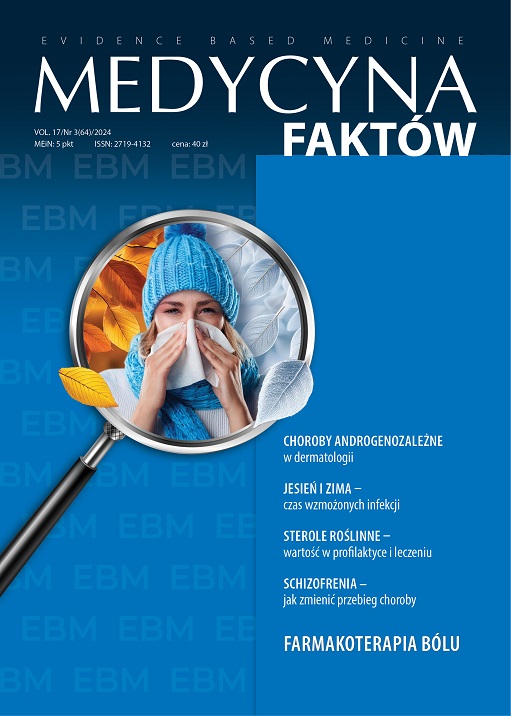Choroby androgenozależne w dermatologii. Kiedy i dlaczego wybieram spironolakton? Artykuł przeglądowy
##plugins.themes.bootstrap3.article.main##
Abstrakt
Spironolakton to lek od ponad 60 lat stosowany w praktyce klinicznej, lecz nadal niedoceniany w wielu aspektach. Mnogość doświadczeń klinicznych związanych ze stosowaniem spironolaktonu przy równoczesnej świetnej znajomości jego profilu bezpieczeństwa i ewentualnych działań niepożądanych pozwala na w pełni świadome i bezpieczne wykorzystywanie leku oraz na dobór dawki adekwatnej do profilu pacjenta. W tym artykule przedstawiono przykłady zastosowań spironolaktonu w chorobach androgenozależnych w dermatologii.
##plugins.themes.bootstrap3.article.details##
Jak cytować
Matusiak, Łukasz. (2024). Choroby androgenozależne w dermatologii. Kiedy i dlaczego wybieram spironolakton? . Medycyna Faktów , 17(3(64), 334-337. https://doi.org/10.24292/01.MF.0324.02
Numer
Dział
Artykuły
Copyright © by Medical Education. All rights reserved.
Bibliografia
1. Bolognia JL, Schaffer JV, Cerroni L et al. Dermatologia, wydanie polskie. Medipage, Warszawa 2022.
2. Bitzer J, Römer T, Lopes da Silva Filho A. The use of cyproterone acetate/ethinyl estradiol in hyperandrogenic skin symptoms – a review. Eur J Contracept Reprod Health Care. 2017; 3: 172-82.
3. Owczarczyk-Saczonek A, Chojnacka-Purpurowicz J, Placek W. Leki antyandrogenowe. Dermatologia po dyplomie 2022; 4: 23-29.
4. Fauser BCJM, Tarlatzis BC, Rebar RW et al. Consensus on women’s health aspects of polycystic ovary syndrome (PCOS): the Amsterdam ESHRE/ ASRM-Sponsored 3rd PCOS Consensus Workshop Group. Fertil Steril. 2012; 97: 28-38.
5. Ozdemir S, Ozdemir M, Görkemli H et al. Specific dermatologic features of the polycystic ovary syndrome and its association with biochemical markers of the metabolic syndrome and hyperandrogenism. Acta Obstet Gynecol Scand. 2010; 89: 199-204.
6. Azziz R, Sanchez L, Knochenhauer ES et al. Androgen excess in women: experience with over 1000 consecutive patients. J Clin Endocrinol Metab. 2004; 89: 453-62.
7. Orfanos CE, Adler YID, Zouboulis CC. The SAHA syndrome. Horm Res. 2000; 54: 251-8.
8. Dreno B, Nguyen JM, Hainaut E et al. Efficacy of Spironolactone Compared with Doxycycline in Moderate Acne in Adult Females: Results of the Multicentre, Controlled, Randomized, Double-blind Prospective and Parallel Female Acne Spironolactone vs doxyCycline Efficacy (FASCE) Study. Acta Derm Venereol. 2024; 104: adv 26002.
9. Patibandla S, Heaton J, Kyaw H. Spironolactone. In: StatPearls. StatPearls Publishing, Treasure Island (FL) 2021.
10. Vargas-Mora P, Morgado-Carrasco D. Spironolactone in Dermatology: Uses in Acne, Hidradenitis Suppurativa, Female Pattern Baldness, and Hirsutism. Uso de la espironolactona en dermatología: acné, hidradenitis supurativa, alopecia femenina e hirsutismo. Actas Dermosifiliogr (Engl Ed). 2020; 111: 639-49.
11. Reynolds RV, Yeung H, Cheng CE et al. Guidelines of care for the management of acne vulgaris. J Am Acad Dermatol. 2024; 90(5): 1006.e1-1006.e30.
12. Szepietowski J, Kapińska-Mrowiecka M, Kaszuba A et al. Trądzik zwyczajny: patogeneza i leczenie. Konsensus Polskiego Towarzystwa Dermatologicznego. Przegl Dermatol. 2012; 99: 649-73.
13. Brough KR, Torgerson RR. Hormonal therapy in female pattern hair loss. Int J Womens Dermatol. 2017; 3: 53-7.
14. Golbari NM, Porter ML, Kimball AB. Antiandrogen therapy with spironolactone for the treatment of hidradenitis suppurativa. J Am Acad Dermatol. 2019; 80: 114-9.
2. Bitzer J, Römer T, Lopes da Silva Filho A. The use of cyproterone acetate/ethinyl estradiol in hyperandrogenic skin symptoms – a review. Eur J Contracept Reprod Health Care. 2017; 3: 172-82.
3. Owczarczyk-Saczonek A, Chojnacka-Purpurowicz J, Placek W. Leki antyandrogenowe. Dermatologia po dyplomie 2022; 4: 23-29.
4. Fauser BCJM, Tarlatzis BC, Rebar RW et al. Consensus on women’s health aspects of polycystic ovary syndrome (PCOS): the Amsterdam ESHRE/ ASRM-Sponsored 3rd PCOS Consensus Workshop Group. Fertil Steril. 2012; 97: 28-38.
5. Ozdemir S, Ozdemir M, Görkemli H et al. Specific dermatologic features of the polycystic ovary syndrome and its association with biochemical markers of the metabolic syndrome and hyperandrogenism. Acta Obstet Gynecol Scand. 2010; 89: 199-204.
6. Azziz R, Sanchez L, Knochenhauer ES et al. Androgen excess in women: experience with over 1000 consecutive patients. J Clin Endocrinol Metab. 2004; 89: 453-62.
7. Orfanos CE, Adler YID, Zouboulis CC. The SAHA syndrome. Horm Res. 2000; 54: 251-8.
8. Dreno B, Nguyen JM, Hainaut E et al. Efficacy of Spironolactone Compared with Doxycycline in Moderate Acne in Adult Females: Results of the Multicentre, Controlled, Randomized, Double-blind Prospective and Parallel Female Acne Spironolactone vs doxyCycline Efficacy (FASCE) Study. Acta Derm Venereol. 2024; 104: adv 26002.
9. Patibandla S, Heaton J, Kyaw H. Spironolactone. In: StatPearls. StatPearls Publishing, Treasure Island (FL) 2021.
10. Vargas-Mora P, Morgado-Carrasco D. Spironolactone in Dermatology: Uses in Acne, Hidradenitis Suppurativa, Female Pattern Baldness, and Hirsutism. Uso de la espironolactona en dermatología: acné, hidradenitis supurativa, alopecia femenina e hirsutismo. Actas Dermosifiliogr (Engl Ed). 2020; 111: 639-49.
11. Reynolds RV, Yeung H, Cheng CE et al. Guidelines of care for the management of acne vulgaris. J Am Acad Dermatol. 2024; 90(5): 1006.e1-1006.e30.
12. Szepietowski J, Kapińska-Mrowiecka M, Kaszuba A et al. Trądzik zwyczajny: patogeneza i leczenie. Konsensus Polskiego Towarzystwa Dermatologicznego. Przegl Dermatol. 2012; 99: 649-73.
13. Brough KR, Torgerson RR. Hormonal therapy in female pattern hair loss. Int J Womens Dermatol. 2017; 3: 53-7.
14. Golbari NM, Porter ML, Kimball AB. Antiandrogen therapy with spironolactone for the treatment of hidradenitis suppurativa. J Am Acad Dermatol. 2019; 80: 114-9.
